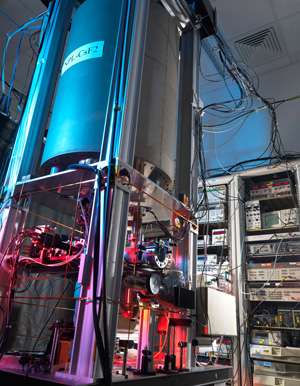Accuracy of the NPL caesium fountain clock further improved

In 2011, the NPL caesium fountain primary frequency standard (NPL-CsF2) was hailed as the most accurate long-term timekeeper in the world, as it would lose or gain only one second in 138 million years. Now, this level of accuracy has been increased further: to one second in 158 million years.
NPL-CsF2 is one of the primary frequency standards most frequently used to calibrate the unit interval of the International Atomic Time (TAI) and Universal Coordinated Time (UTC) - the worldwide timescales used for global communications, satellite navigation and time stamping of financial transactions.
To improve the accuracy of the clock, NPL scientists make physical measurements and use mathematical models to evaluate and reduce any uncertainties within the system. One source of uncertainty is a frequency shift that occurs when a clock atom collides with an atom of background gas. As atomic clocks have become more accurate, this source of uncertainty has grown to become more significant.
Recent research from long-term collaborators at Penn State University in the USA produced a model to evaluate and reduce the systematic errors caused by these types of atom collisions. Further research from NPL scientists has used this model to evaluate the long term uncertainty of NPL-CsF2, resulting in a drop in this uncertainty from 2.3 x 10-16 to 2.0 x 10-16. This new, lower uncertainty is equivalent to the clock losing or gaining one second in 158 million years.
Krzysztof Szymaniec, who led the project at NPL, said:
"This new research has further reduced the uncertainties associated with NPL's caesium fountain clock, ensuring it remains among the most accurate timekeepers in the world."
The methods used in the research can also be used to evaluate the caesium fountain clocks in other national laboratories, improving the world's accurate methods of keeping time.
The NPL research was published in IEEE Transactions on Ultrasonics, Ferroelectrics, and Frequency Control
The Penn State University research was published in Physical Review Letters
While NPL continues to maintain and improve the UK's primary frequency standard, scientists are also looking to develop next generation frequency standards, which will be based on optical, rather than microwave, frequencies. NPL's Helen Margolis recently published an article in Nature Physics entitled 'Timekeepers of the future', exploring advances in optical atomic clocks and the possibility of a future redefinition of the second, the SI unit of time.
More information: "Timekeepers of the future." Helen Margolis. Nature Physics (2014) DOI: 10.1038/nphys2834. Published online 12 January 2014
"Scattering of Cold-Atom Coherences by Hot Atoms: Frequency Shifts from Background-Gas Collisions." Kurt Gibble. Phys. Rev. Lett. 110, 180802 (2013) [5 pages]
Journal information: Physical Review Letters , Nature Physics
Provided by National Physical Laboratory



















